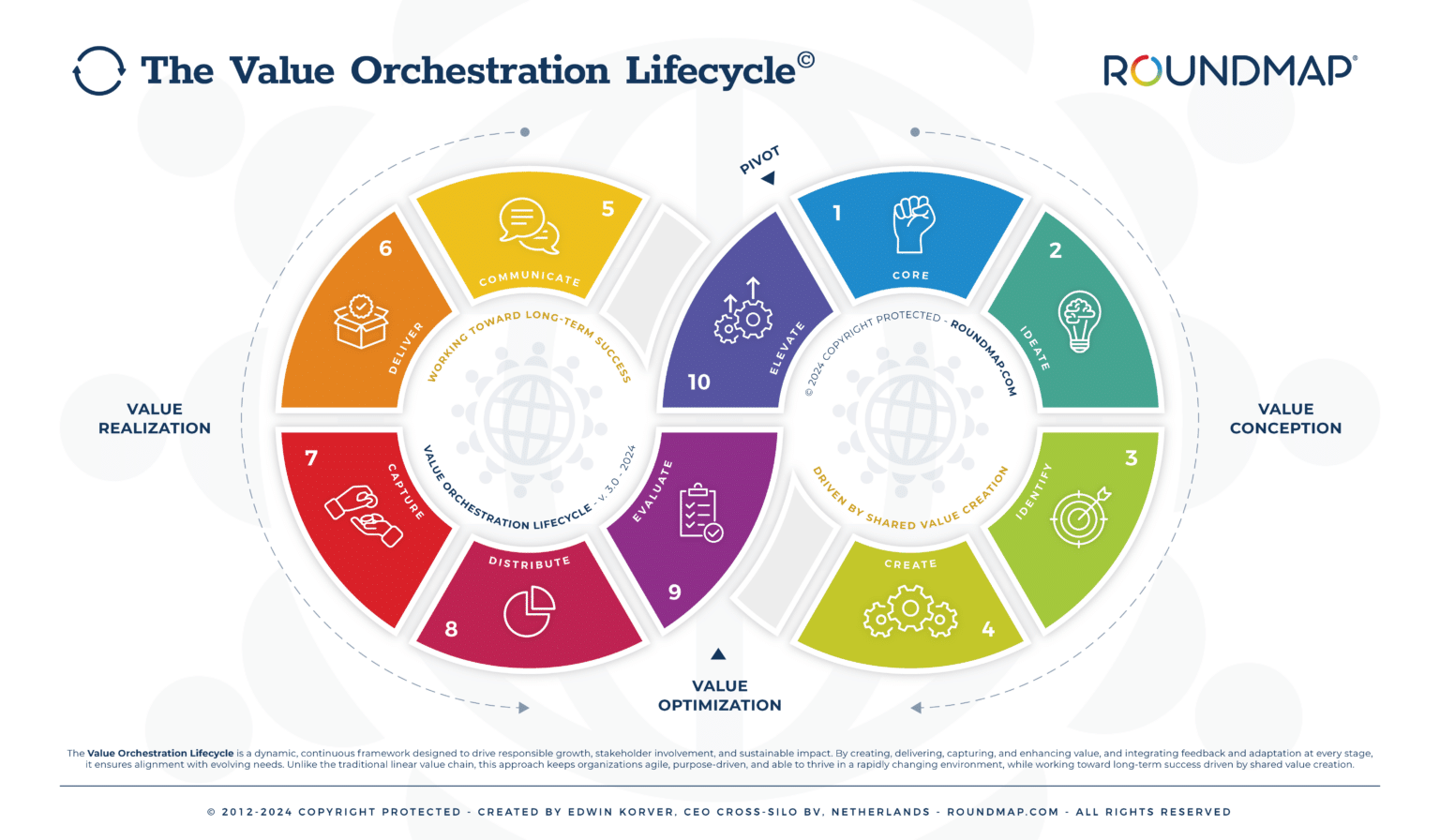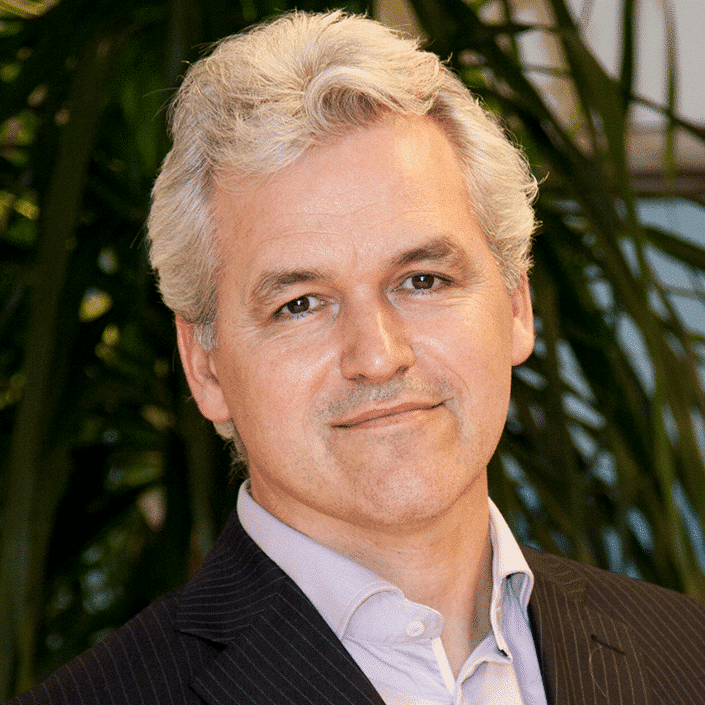In a world facing mounting challenges—social inequality, environmental degradation, and short-termism in business—organizations must evolve to thrive. The Value Orchestration Lifecycle offers a transformative approach for businesses committed to achieving long-term success by fostering ethical prosperity and responsible growth. At its core, it is a cyclical framework that transcends traditional, linear business models and introduces a holistic, adaptive way of creating value that benefits all stakeholders, not just shareholders.
1. Moving Beyond Profit-First Thinking: Ethical Prosperity
Traditional business models focus almost exclusively on maximizing shareholder value. However, such approaches often lead to unintended consequences: the externalization of costs to society and the environment, inequitable profit distribution, and a narrow view of business success. The Value Orchestration Lifecycle challenges this thinking by emphasizing ethical prosperity—pursuing profits without sacrificing social, environmental, and stakeholder well-being.
The framework’s ten-step process, beginning with the Value Core, ensures that every action an organization takes is rooted in its values, strengths, and purpose. Ethical prosperity emerges when businesses build on this foundation, creating a balanced and fair system that values the contributions of all stakeholders—employees, customers, suppliers, communities, and the environment. It is a shift from simply ‘doing well’ to ‘doing well by doing good.’
2. Fostering Responsible Growth: Long-Term Impact Over Short-Term Gains
The pressure to deliver short-term financial gains has historically driven businesses to overlook long-term sustainability. However, responsible growth is achieved when organizations build systems that leverage their strengths and scale their impact without compromising future success. The Value Orchestration Lifecycle provides businesses the strategic flexibility to adapt continuously while remaining committed to long-term goals.
At the heart of responsible growth is the idea that organizations must leverage impact—not simply maximize it. This means creating positive, scalable outcomes while mitigating any adverse effects. The framework helps businesses establish collaborative partnerships through shared value networks, enabling organizations to align internally and externally to generate meaningful, sustainable growth.
3. Breaking Corporate Isolationism: The Power of Shared Value Networks
Siloed, profit-driven entities operating in isolation are no longer viable in today’s interconnected world. The Value Orchestration Lifecycle breaks the myth of corporate isolationism by championing collaboration within shared value networks—ecosystems of companies, stakeholders, and partners working together toward shared goals. These networks transcend traditional supply chains, lobbying groups, or interest-based alliances; they are built on trust, transparency, and a commitment to shared prosperity.
By enabling internal (cross-functional) and external (cross-company) alignment, the Lifecycle allows businesses to coordinate efforts and maximize collective strengths. This interconnectedness amplifies positive impact, mitigates adverse outcomes, and fosters innovation, all while delivering long-term, responsible growth for everyone involved.
4. Cyclical, Adaptive, and Future-Proof: The Antidote to Linear Models
One of the defining characteristics of the Value Orchestration Lifecycle is its cyclical nature. Unlike linear models that push for efficiency at the expense of adaptability, this framework emphasizes continuous learning, feedback, and innovation. It incorporates key stages—Value Ideation, Value Identification, Creation, Communication, Delivery, Capture, Evaluation, and Elevation—that allow businesses to reflect, refine, and optimize their strategies in real time.
This ongoing cycle ensures that organizations remain relevant and resilient, capable of adjusting to market changes, customer needs, and evolving societal expectations. The Value Orchestration Lifecycle enables businesses to become antifragile—growing stronger and more aligned with each cycle, especially during periods of uncertainty.
5. Equitable Profit Distribution: The Foundation of Ethical Growth
One of the most significant departures from traditional models is the Cycle’s emphasis on equitable profit distribution. Value is not created by leadership alone but by all stakeholders involved in bringing a business to life. The Value Orchestration Lifecycle ensures that all contributors are fairly rewarded, aligning profit with purpose.
The system’s inherent flexibility allows each organization to define what ‘fair’ means according to its values, ensuring that compensation, recognition, and rewards align with the contributions of employees, partners, and communities. This sense of fairness fosters deeper engagement, trust, and long-term relationships, all vital components of ethical prosperity.
6. Transparency and Trust: Redefining Governance for a New Era
Businesses that thrive long-term do so by building trust—not just with customers but with all stakeholders. The Value Orchestration Lifecycle encourages organizations to adopt transparent governance structures that represent multiple stakeholders’ interests, not just those of shareholders. This helps build resilient, trust-based relationships, ensuring sustainable growth and stakeholders’ investment in the business’s success.
The framework advocates for unbiased reporting bodies, ensuring transparent evaluation and accountability for decisions that affect employees, communities, and the environment. This commitment to transparency is the bedrock of responsible growth.
7. Innovation Embedded in Every Step: Constant Evolution for Market Leadership
In today’s rapidly evolving landscape, innovation is the difference between thriving and becoming obsolete. The Value Orchestration Lifecycle embeds innovation into every step of the process—from Ideation to Evaluation. It encourages businesses to remain curious, continuously iterate, and refine their offerings, services, and strategies.
This framework doesn’t just help businesses react to change; it positions them as leaders, capable of driving transformation in their industries and markets. With built-in feedback loops and a focus on stakeholder-driven insights, the Cycle ensures that organizations remain agile and adaptable in the face of disruption.
Conclusion
The Value Orchestration Lifecycle is more than a tool—it is a strategic approach for building businesses that are resilient, responsible, and ready for the future. Focusing on ethical prosperity, responsible growth, equitable profit distribution, and collaboration through shared value networks offers a roadmap for companies seeking long-term success in a world that demands more from businesses than ever before. It is the ultimate tool for those ready to lead with purpose, transparency, and impact, fostering their success and the success of society and the planet as a whole.
Continue Reading:

Mapping the Future: We’re Writing the Book on RoundMap®
At RoundMap®, we believe the future of business lies in wholeness, not fragmentation. For too long, organizations have been shaped by linear thinking, short-term gains,

More Than Crumbs: The Case for True Value Creation
For decades, shareholder primacy has dictated corporate decision-making, driving businesses to prioritize short-term profits and disproportionate returns to shareholders over long-term sustainability and stakeholder value.

Beyond Extraction: Why Regenerative Business is the Only Way Forward
The RoundMap’s Regenerative Business Framework proposes a dual-cycle approach to business: one focused on value creation and another on impact. However, reality presents us with

RoundMap Regenerative Business Framework: Empowering the Present while Building the Future
Executive Summary The Regenerative Business Framework addresses the critical need for businesses to move beyond mere profitability toward regenerative practices that drive long-term growth and

The Two Cycles: Intertwining the Profit Cycle and Purpose Cycle
What if meeting today’s needs could also shape a better tomorrow? At first glance, the concepts of value creation and impact creation might seem interchangeable.

The RoundMap Flywheel: A Shift Toward Sustainable Ecosystem Resilience
What if impact creation was as strategic and intentional as value creation? What if every dollar earned didn’t just fuel a business’s bottom line but

From Striving to Thriving: How Amazon is a Strive-Driven Giant Failing to Thrive
Amazon has become synonymous with business success, often hailed as a master of efficiency, customer obsession, and innovation. At the heart of its growth strategy

Impact Strategies to Amplify Value and Mitigate Harm Across Stakeholders
What if doing the right thing wasn’t just a moral choice but a strategic one? What if amplifying your organization’s positive impact while mitigating harm

From Extraction to Contribution: Thriving Together with Shared Success
The Flywheel of Shared Success is designed to demonstrate that staying within the boundaries of responsible growth doesn’t mean limiting our ambitions—it means channeling them

The Twin Engines of Progress: Returns on Value and Impact
At the heart of the Flywheel of Shared Success lies the powerful interplay between Value Returns and Impact Returns, both of which operate on the

From Hopping for Cash to Building Bridges: Why Self-Interest Alone Can’t Sustain Shared Prosperity
What we’re proposing with the Flywheel of Shared Success is nothing short of a call to confront and correct our deeply flawed execution of Adam

The Impact Chain Framework: Transforming Values into Shared Success
The Impact Chain operates alongside the Value Chain, complementing its focus on value creation and economic profit. While the Value Chain transforms activities into financial
Author
-
Edwin Korver is a polymath celebrated for his mastery of systems thinking and integral philosophy, particularly in intricate business transformations. His company, CROSS/SILO, embodies his unwavering belief in the interdependence of stakeholders and the pivotal role of value creation in fostering growth, complemented by the power of storytelling to convey that value. Edwin pioneered the RoundMap®, an all-encompassing business framework. He envisions a future where business harmonizes profit with compassion, common sense, and EQuitability, a vision he explores further in his forthcoming book, "Leading from the Whole."
View all posts Creator of RoundMap® | CEO, CROSS-SILO.COM




